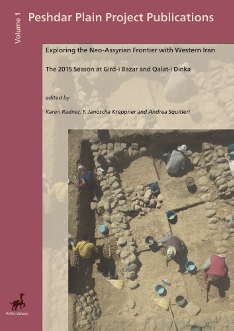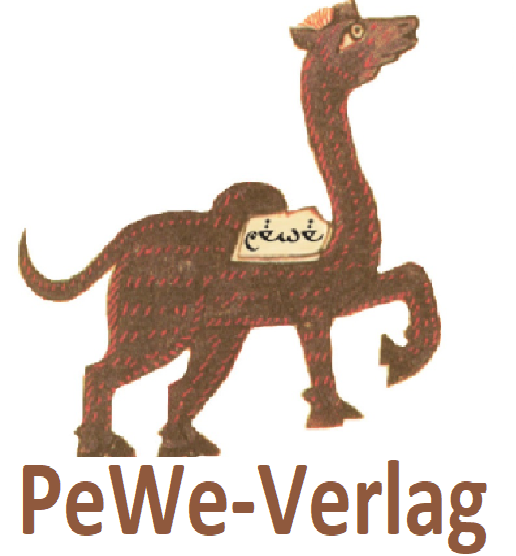
Exploring the Neo-Assyrian Frontier with Western Iran.
The 2015 Season at Gird-i Bazar and Qalat-i Dinka
Peshdar Plain Project Publications — Volume 1
Format: 30 x 21 cm — Hardcover
Umfang: 128 Seiten, mehr als 60 farbige Abbildungen
ISBN: 978-3-935012-20-1
Preis: 29,80 €
© PeWe-Verlag 2016
Mit Beiträgen von Mark Altaweel, Andrei Ašandulesei, Peter V. Bartl, Jörg Fassbinder, Christoph Forster, Jessica Giraud, Tina Greenfield, Zahra Hashmi, Jean-Jacques Herr, F. Janoscha Kreppner, John MacGinnis, Anke Marsh, Karen Radner, Andrea Squitieri, Adam B. Stone, Eleanor Barbanes Wilkinson
Eingebettet in die außergewöhnliche Berglandschaft des Zagros-Gebirges liegt die Peshdar-Ebene im Distrikt Qaladze in der Provinz Sulaymaniyah. Damit befindet sie sich in der Autonomen Kurdischen Region des Iraks, direkt an der Grenze zum Iran am Oberlauf des Unteren Zab. Das Peshdar Plain Project wurde im Jahr 2015 ins Leben gerufen und zielt darauf ab, die alte Geschichte dieses bisher wissenschaftlich vernachlässigten Gebietes zu erforschen. Besonderes Interesse gilt dabei der Zeit zwischen dem 9. und dem 7. Jahrhundert v. Chr., in der das Neuassyrische Reich diese Gegend kontrollierte. Als Teil der „Grenzmark des Palastherolds“ lag die Peshdar-Ebene damals an der Grenze zu den wichtigen Klientenstaaten Hubuschkia, Mannea und Musasir.
Der erste Band der Reihe Peshdar Plain Project Publications legt die Ergebnisse der ersten Feldkampagne 2015 vor. Die Forschungen konzentrierten sich auf zwei Fundstätten, die in neuassyrischer Zeit Teil eines Siedlungskomplexes darstellen: das winzige Gird-i Bazar ist in der Ebene gelegen, während Qalat-i Dinka eindrucksvoll auf einem Felssporn über dem Unteren Zab liegt. An beiden Orten wurden geophysikalische Prospektionen vorgenommen, bevor in Gird-i Bazar mit der Ausgrabung begonnen wurde. Die einphasige Siedlung aus einfachen Einraumhäusern, die hier zutage tritt, bietet nicht nur die vergleichsweise seltene Gelegenheit, einen nicht der Elite gewidmeten Lebensraum neuassyrischer Zeitstellung zu erforschen, sondern wegen ihrer Grenzlage auch die hochwillkommene Chance, die Keramikkulturen Westirans (Hasanlu, Godin Tepe, Nush-i Jan und Baba Jan), mit der assyrischen Produktion des 8. und 7. Jahrhunderts zu synchronisieren. C14-Daten von Holzkohlefunden sichern die Datierung ab.
Die Präsentation der Survey- und Grabungsergebnisse sowie der ersten Auswertung der Keramik nach Technologie, Waren, Morphologie wird begleitet von einer Diskussion der historischen Geographie (auch auf der Grundlage einer ins Jahr 725 v. C. Tontafel aus Qalat-i Dinka), einem Kapitel zu den Ergebnissen der Oberflächenbegehungen in den Jahren 2013 und 2015 durch die Mission archéologique française du Gouvernorat de Soulaimaniah (MAFGS) und einer Analyse der geoarchäologischen Situation, wobei die Identifizierung eines Qanat-Systems zur Bewässerung der Ebene besonders hervorzuheben ist.
In einem Appendix werden die Ergebnisse der geophysikalischen Prospektion in Mujeser vorgestellt. Dieser Fundort ist im Distrikt Soran in der Provinz Erbil gelegen und wohl mit der gleichnamigen Hauptstadt des assyrischen Klientenstaates Musasir zu identifizieren, mit dem berühmten Tempel des Haldi. Die Magnetometerdaten stützen diese zuerst von R. M. Boehmer formulierte These weiter ab.
With contributions of Mark Altaweel, Andrei Ašandulesei, Peter V. Bartl, Jörg Fassbinder, Christoph Forster, Jessica Giraud, Tina Greenfield, Zahra Hashmi, Jean-Jacques Herr, F. Janoscha Kreppner, John MacGinnis, Anke Marsh, Karen Radner, Andrea Squitieri, Adam B. Stone, Eleanor Barbanes Wilkinson
The Peshdar district is part of the province of Sulaymaniyah in the Kurdish Autonomous Region of Iraq. In its centre lies the Peshdar Plain, surrounded by the glorious mountainscape of the Zagros and bounded in the south by the valley of the Lesser Zab, which connects the region to the Assyrian heartland and Western Iran. The international and interdisciplinary Peshdar Plain Project was inaugurated in 2015 with the goal of investigating the region in the Neo-Assyrian period (9th to 7th century BC). It formed part of the Border March of the Palace Herald which served to negotiate relations with the adjoining client kingdoms in the Zagros, most importantly Mannea (south of Lake Urmiye), Ḫubuškia in the Sardasht Plain and Muṣaṣir in the Rowanduz Plain.
Work in 2015 focused on two closely connected sites in the small Bora Plain, a sub-unit of the Peshdar Plain: the tiny single-phase site Gird-i Bazar and impressive Qalat-i Dinka, looming on a rocky outcrop high over the river, both part of the Dinka settlement complex. This book presents the results of this first season of field work. Karen Radner offers an analysis of the historical geography of the region on the basis of the textual sources, including the private contract of 725 BC found at Qalat-i Dinka. Mark Altaweel and Anke March provide a geoarchaeological assessment of the Bora Plain while Jessica Giraud presents an evaluation of the Dinka settlement complex based on the results of the survey of the Mission archéologique française du Gouvernorat de Soulaimaniah (MAFGS). Jörg Fassbinder and Andrei Ašandulesei discuss the results of their geophysical survey at Gird-i Bazar and Qalat-i Dinka. The bulk of the volume is dedicated to the 2015 excavations at Gird-i Bazar, with contributions on the fieldwork by F. Janoscha Kreppner, Christoph Forster, Andrea Squitieri, John MacGinnis, Adam B. Stone and Peter V. Bartl. Tina Greenfield introduces the bioarchaeological sampling strategy. On the basis of the analysis of 666 diagnostic ceramic sherds from key find contexts and by drawing on parallels from the Assyrian heartland and western Iran, Jean-Jacques Herr presents a first assessment of the technical aspects, the fabrics and the shapes of the pottery excavated at Gird-i Bazar. Eleanor Barbanes Wilkinson, Andrea Squitieri and Zahra Hashemi present the small finds from the 2015 excavations.
In an appendix to the volume, Jörg Fassbinder presents the promising results of the 2014 magnetometer survey in Mujeser in the Soran district of the province of Erbil, the possible site of the capital of the kingdom of Muṣaṣir, a client state of the Assyrian Empire, and its famous Ḫaldi temple.
The research presented in this book throws light on a hitherto little known eastern frontier region of the Assyrian Empire. Gird-i Bazar is the first unequivocally Neo-Assyrian site to be excavated in the region. The occupation layers beginning to be uncovered there offer the rare opportunity to explore an Assyrian non-elite settlement. Its well stratified ceramic repertoire is of special importance as it allows us for the first time to synchronise the Western Iranian pottery cultures (with the key sites Hasanlu, Godin Tepe, Nush-i Jan and Baba Jan) with the Assyrian material of the 8th and 7th centuries BC.
